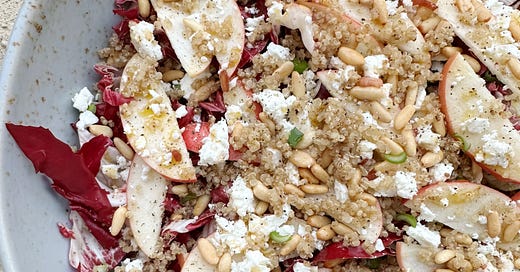How to make a perfect bowl of cacio e pepe, and a tangy radicchio and quinoa salad.
Plus, a new February playlist from André.
Radicchio and Quinoa Salad with Apple, Pine nuts, and Scallions
It's another radicchio salad, folks, because this vegetable is EVERYWHERE in Italy right now. And, not just one kind of radicchio; at any farmer's market or supermarket, I usually see at least 3-4 varieties, if not more, including Castelfranco, Treviso, and Chioggia. Any radicchio you can get your hands on would work in this salad, and if you can't find radicchio, a crunchy lettuce like Little Gems will also do the trick. And when building a great salad, I think a lot about how the ingredients' different flavors and textures will complement each other. For this one, the pine nuts add a nice toasty crunch, while the feta adds a salty, creamy layer of flavor. And the apples and quinoa add even more texture, tang, and earthiness to this bowl of goodness.
RADICCHIO AND QUINOA SALAD WITH APPLE, PINE NUTS, AND FETA
Serves 4
1 head of radicchio, leaves cut into strips or torn into pieces
1 scallion, ends trimmed, sliced into thin rounds
1 small pink lady apple, cut into thin half-moons
1/4 cup pine nuts, toasted
2/3 cup cooked quinoa
2/3 cup crumbled feta
Black pepper
Sea salt
RED WINE VINAIGRETTE
1/4 cup red wine vinegar
1 tablespoon minced shallot
1/2 teaspoon sea salt
Freshly ground black pepper
1/2 cup extra virgin olive oil
First, prepare your vinaigrette. In a small bowl, combine the red wine vinegar and shallot. Let it sit for 10 minutes. Add the salt and some pepper, then slowly drizzle in the olive oil, whisking as it emulsifies. Set aside.
In a large mixing bowl, add the radicchio, scallion, apple, pine nuts, cooked quinoa, and feta. Slowly drizzle some of the vinaigrette on the ingredients and gently toss to coat. Taste. Add vinaigrette until the radicchio leaves are lightly coated (you will have vinaigrette left over). Season with more sea salt and black pepper if needed, and serve.
Cacio e Pepe
I first had Cacio e Pepe during our honeymoon in Rome. Andre took me to one of his favorite hole-in-the-wall restaurants (sadly no longer there), and a loving Italian grandma prepared the dish for me. It felt like I was in my very own movie. She placed the bowl of warm spaghetti showered in freshly grated Pecorino Romano and black pepper in front of me, and I was instructed to start mixing. I enthusiastically picked up my fork and vigorously stirred the ingredients until a creamy, glistening sauce coated every strand. As I began to devour this bowl of perfect Cacio e Pepe, my mind was blown, and my love of simple food expanded exponentially. It was a revelation—something so simple yet so exceptionally delicious. So, of course, upon arriving home after our honeymoon, I prepared this simple Roman pasta dish, and oh, what a disappointment it was. It was a stringy, coagulated, cheesy mess! What had I done wrong?! For anyone who has ever tried to create this dish at home, you have probably been met with this on more than one occasion. And this is the hardest thing about Cacio e Pepe. Yes, the ingredients are simple, and the dish seems simple to prepare, but it must be done just right. Also, it's best made individually or two at a time. Over the years, we have learned a few things that make a huge difference in how our Cacio e Pepe turns out, and we've also found the method with which we consistently have the best outcome.
Keep reading with a 7-day free trial
Subscribe to Barrett and The Boys to keep reading this post and get 7 days of free access to the full post archives.






